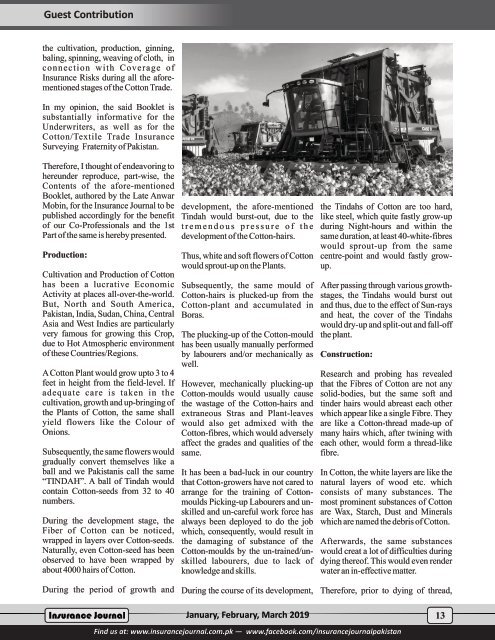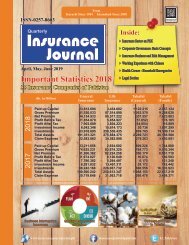Insurance Journal (1st Quarter 2019)
Create successful ePaper yourself
Turn your PDF publications into a flip-book with our unique Google optimized e-Paper software.
Guest Contribution<br />
the cultivation, production, ginning,<br />
baling, spinning, weaving of cloth, in<br />
connection with Coverage of<br />
<strong>Insurance</strong> Risks during all the aforementioned<br />
stages of the Cotton Trade.<br />
In my opinion, the said Booklet is<br />
substantially informative for the<br />
Underwriters, as well as for the<br />
Cotton/Textile Trade <strong>Insurance</strong><br />
Surveying Fraternity of Pakistan.<br />
Therefore, I thought of endeavoring to<br />
hereunder reproduce, part-wise, the<br />
Contents of the afore-mentioned<br />
Booklet, authored by the Late Anwar<br />
Mobin, for the <strong>Insurance</strong> <strong>Journal</strong> to be<br />
published accordingly for the benefit<br />
of our Co-Professionals and the <strong>1st</strong><br />
Part of the same is hereby presented.<br />
Production:<br />
Cultivation and Production of Cotton<br />
has been a lucrative Economic<br />
Activity at places all-over-the-world.<br />
But, North and South America,<br />
Pakistan, India, Sudan, China, Central<br />
Asia and West Indies are particularly<br />
very famous for growing this Crop,<br />
due to Hot Atmospheric environment<br />
of these Countries/Regions.<br />
A Cotton Plant would grow upto 3 to 4<br />
feet in height from the field-level. If<br />
adequate care is taken in the<br />
cultivation, growth and up-bringing of<br />
the Plants of Cotton, the same shall<br />
yield flowers like the Colour of<br />
Onions.<br />
Subsequently, the same flowers would<br />
gradually convert themselves like a<br />
ball and we Pakistanis call the same<br />
“TINDAH”. A ball of Tindah would<br />
contain Cotton-seeds from 32 to 40<br />
numbers.<br />
During the development stage, the<br />
Fiber of Cotton can be noticed,<br />
wrapped in layers over Cotton-seeds.<br />
Naturally, even Cotton-seed has been<br />
observed to have been wrapped by<br />
about 4000 hairs of Cotton.<br />
During the period of growth and<br />
development, the afore-mentioned<br />
Tindah would burst-out, due to the<br />
t r e m e n d o u s p r e s s u r e o f t h e<br />
development of the Cotton-hairs.<br />
Thus, white and soft flowers of Cotton<br />
would sprout-up on the Plants.<br />
Subsequently, the same mould of<br />
Cotton-hairs is plucked-up from the<br />
Cotton-plant and accumulated in<br />
Boras.<br />
The plucking-up of the Cotton-mould<br />
has been usually manually performed<br />
by labourers and/or mechanically as<br />
well.<br />
However, mechanically plucking-up<br />
Cotton-moulds would usually cause<br />
the wastage of the Cotton-hairs and<br />
extraneous Stras and Plant-leaves<br />
would also get admixed with the<br />
Cotton-fibres, which would adversely<br />
affect the grades and qualities of the<br />
same.<br />
It has been a bad-luck in our country<br />
that Cotton-growers have not cared to<br />
arrange for the training of Cottonmoulds<br />
Picking-up Labourers and unskilled<br />
and un-careful work force has<br />
always been deployed to do the job<br />
which, consequently, would result in<br />
the damaging of substance of the<br />
Cotton-moulds by the un-trained/unskilled<br />
labourers, due to lack of<br />
knowledge and skills.<br />
During the course of its development,<br />
the Tindahs of Cotton are too hard,<br />
like steel, which quite fastly grow-up<br />
during Night-hours and within the<br />
same duration, at least 40-white-fibres<br />
would sprout-up from the same<br />
centre-point and would fastly growup.<br />
After passing through various growthstages,<br />
the Tindahs would burst out<br />
and thus, due to the effect of Sun-rays<br />
and heat, the cover of the Tindahs<br />
would dry-up and split-out and fall-off<br />
the plant.<br />
Construction:<br />
Research and probing has revealed<br />
that the Fibres of Cotton are not any<br />
solid-bodies, but the same soft and<br />
tinder hairs would abreast each other<br />
which appear like a single Fibre. They<br />
are like a Cotton-thread made-up of<br />
many hairs which, after twining with<br />
each other, would form a thread-like<br />
fibre.<br />
In Cotton, the white layers are like the<br />
natural layers of wood etc. which<br />
consists of many substances. The<br />
most prominent substances of Cotton<br />
are Wax, Starch, Dust and Minerals<br />
which are named the debris of Cotton.<br />
Afterwards, the same substances<br />
would creat a lot of difficulties during<br />
dying thereof. This would even render<br />
water an in-effective matter.<br />
Therefore, prior to dying of thread,<br />
<strong>Insurance</strong> <strong>Journal</strong> January, February, March <strong>2019</strong><br />
13<br />
Find us at: www.insurancejournal.com.pk — www.facebook.com/insurancejournalpakistan

















